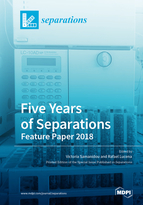Five Years of Separations: Feature Paper 2018
A special issue of Separations (ISSN 2297-8739).
Deadline for manuscript submissions: closed (31 January 2019) | Viewed by 50272
Special Issue Editors
Interests: analytical chemistry; sample preparation; chromatography; HPLC; method validation; method development; separation science; food analysis; bioanalysis; environmental analysis; green analytical chemistry; sorptive extraction; microextraction techniques
Special Issues, Collections and Topics in MDPI journals
Interests: sample preparation; microextraction; nanoparticles and ionic liquid
Special Issues, Collections and Topics in MDPI journals
Special Issue Information
Dear Colleagues,
To celebrate the fifth year of the publication of Separations, we have the honor to edit a new Special Issue. The Special Issue will collect original research papers from the frontiers of separation research, as well as review articles from prominent scholars, highlighting the state-of-the-art of separation science and technology. We invite researchers and technologists, whose work focuses on separations and related applications, to contribute with papers disseminating their excellent research findings. We consider that this issue can provide a multidisciplinary approach to separation techniques and it will be the best forum for sharing innovative ideas in the field.
We are looking forward to receiving your work.
Prof. Dr. Victoria F. Samanidou
Prof. Dr. Rafael Lucena
Guest Editors
Manuscript Submission Information
Manuscripts should be submitted online at www.mdpi.com by registering and logging in to this website. Once you are registered, click here to go to the submission form. Manuscripts can be submitted until the deadline. All submissions that pass pre-check are peer-reviewed. Accepted papers will be published continuously in the journal (as soon as accepted) and will be listed together on the special issue website. Research articles, review articles as well as short communications are invited. For planned papers, a title and short abstract (about 100 words) can be sent to the Editorial Office for announcement on this website.
Submitted manuscripts should not have been published previously, nor be under consideration for publication elsewhere (except conference proceedings papers). All manuscripts are thoroughly refereed through a single-blind peer-review process. A guide for authors and other relevant information for submission of manuscripts is available on the Instructions for Authors page. Separations is an international peer-reviewed open access monthly journal published by MDPI.
Please visit the Instructions for Authors page before submitting a manuscript. The Article Processing Charge (APC) for publication in this open access journal is 2600 CHF (Swiss Francs). Submitted papers should be well formatted and use good English. Authors may use MDPI's English editing service prior to publication or during author revisions.







